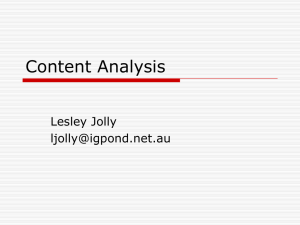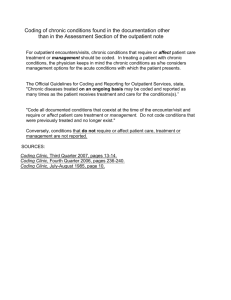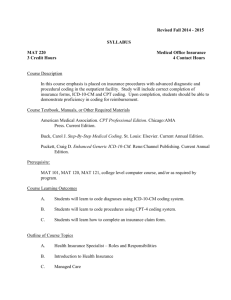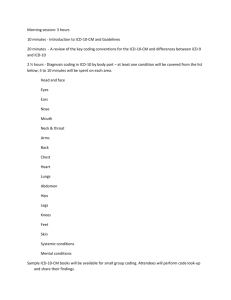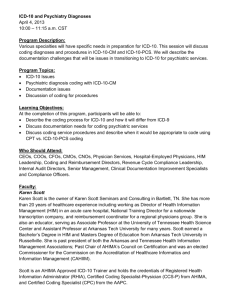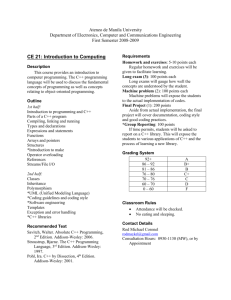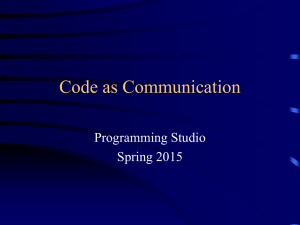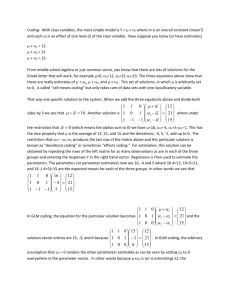Transition to ICD 10 CM/PCS – Mental – Respiratory Diseases Part I
advertisement
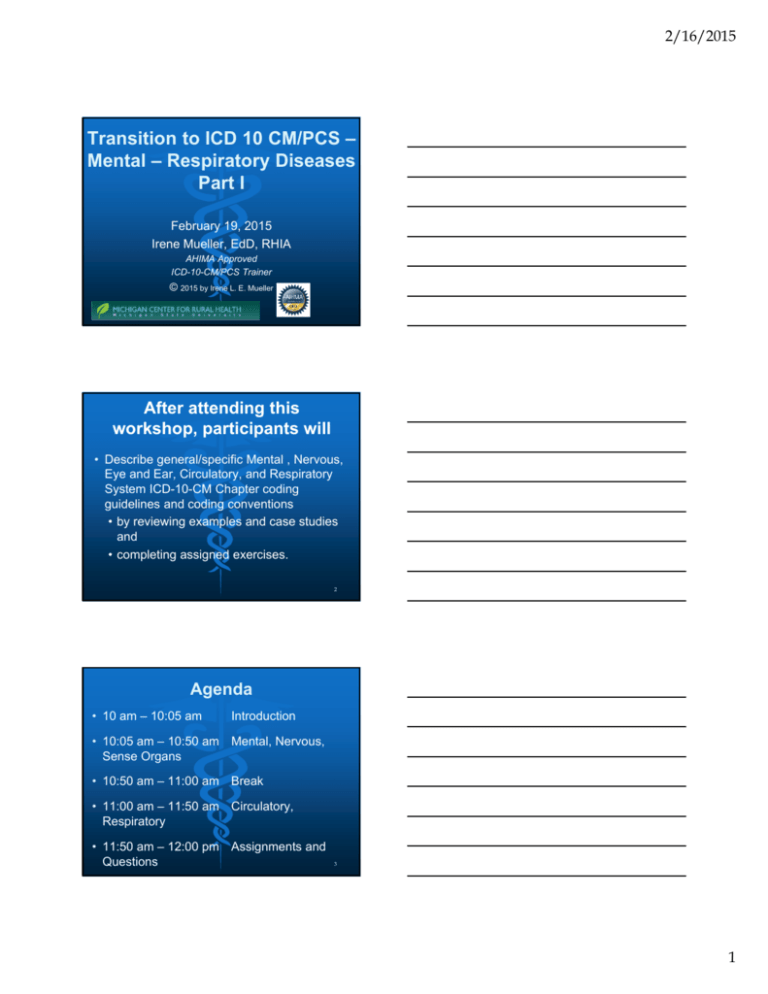
2/16/2015
Transition to ICD 10 CM/PCS –
Mental – Respiratory Diseases
Part I
February 19, 2015
Irene Mueller, EdD, RHIA
AHIMA Approved
ICD-10-CM/PCS Trainer
© 2015 by Irene L. E. Mueller
After attending this
workshop, participants will
• Describe general/specific Mental , Nervous,
Eye and Ear, Circulatory, and Respiratory
System ICD-10-CM Chapter coding
guidelines and coding conventions
• by reviewing examples and case studies
and
• completing assigned exercises.
2
Agenda
• 10 am – 10:05 am
Introduction
• 10:05 am – 10:50 am Mental, Nervous,
Sense Organs
• 10:50 am – 11:00 am Break
• 11:00 am – 11:50 am Circulatory,
Respiratory
• 11:50 am – 12:00 pm Assignments and
Questions
3
1
2/16/2015
Readings for February 2015
• Basic 1CD-10CM/PCS Coding.
2013 ed.
• Schraffenberger,
Lou Ann
• AHIMA
AC200512
• ISBN 978-158426-368-5
•
•
•
•
•
•
Chapter 8, pp. 135-145
Chapter 9, pp. 149-160
Chapter 10, pp. 163-171
Chapter 11, pp. 175-182
Chapter 12, pp. 187-212
Chapter 13, pp. 222- 241
Feedback from 1st Webinar
• Website for Homework Coding
• http://www.icd10data.com/ICD10CM/Codes
• 2013 Book is fine, since ICD-10-CM/PCS
has been frozen/postponed twice
• Speed of 1st webinar – Should be better
from now on
• Added slide numbers
5
Basic ICD-10-CM
Coding Steps
•
•
•
•
•
ID all main terms in dx statement
ID all modifiers (subterms) in dx statement
Locate mainterm(s) in AI (disease, condition)
Locate subterm(s) (site, etiology, clinical type)
Follow any cross-references IF not under 1st
code
p. 27
• Verify tentative code in TL
• Follow any instructions
• Assign codes to highest level of specificity
2
2/16/2015
Basic Coding Steps
• Main Term usually a NOUN, at end of Dx
(Urinary Tract Infection)
• Pneumonia
• Anomaly, Aquired Deformity
• Status
• Modifiers usually ADJECTIVE
• Body Part (Myocardial)
• Etiology (Infectious)
• Often, coder begins using last word in Dx
statement and works to beginning
• STEMI
7
F01-F99
MENTAL, BEHAVIORAL, &
NEURODEVELOPMENTAL
DISORDERS
pp. 135-145
ICD-10-CM Chapter 5 Blocks
9
3
2/16/2015
Chapter 5 Changes
• Drug use – NOT Abuse OR Dependence
• Substance use, Abuse and Dependence
• Include updated terminology
• Classified/coded differently in ICD-10-CM
• 3 different categories for
p. 136
• Alcohol dependence
• Drug dependence
• Non-dependent abuse of drugs
• More combination codes
• for alcohol and drug use/related conditions
(hallucinations, withdrawal, etc.).
10
Chapter 5 Changes
• APA (publishers of Diagnostic and Statistical
Manual of Mental Disorders, or DSM-IV/V) and
CDC worked together to better align DSM-IV/V
and ICD-10-CM Mental Disorders classification
• Terms such as “substance abuse” or “substance
dependence” separate conditions
• “Disorder“ used, NOT "disease" or“ illness“
• Disorder = clinically recognizable set of symptoms
or behavior associated, in most cases,
w/interference with personal function and distress
p. 137
11
Chapter 5 Changes
•
•
•
•
Some conditions classified differently
Clinical terminology also different
Much greater detail – Multiple coding
More categories and codes
p. 139
• Ex: Schizophrenia and delusional disorders
• New categories—schizotypal disorder &
undifferentiated schizophrenia
• New sequencing
• Organizational Changes
• Updated and standardized Terminology
12
4
2/16/2015
Chapter 5 Changes
• Substance use, Abuse and Dependence
(cont.)
pp. 140-143
• Codes ID
• Aspects of use (withdrawal state)
• Effects (abuse and dependence)
• Manifestations (alcohol abuse with alcoholinduced delirium
• Substance involved indicated in
• 2nd/3rd characters
• Clinical state indicated in
• 4th/5th characters
13
Chapter 5 Guidelines
• New in ICD-10-CM
• Detailed coding guidelines provided for
certain conditions, such as
• Pain disorders with related psychological
factors
• Mental and behavioral disorders due to
psychoactive substance use and psychoactive
substance use
• Abuse and dependence
14
Chapter 5 Guidelines
• Pain Disorders related to psychological factors
• Code F45.41 = Pain disorders related exclusively to
psychological disorders
• Code F45.42 = Pain disorders w/related psychological
factors
• Used w/G89. Pain, NEC IF documentation of psychological
component for patient with acute /chronic pain.
• Codes only assigned based on provider
documentation AND when definition of reportable
diagnosis met
• Chapter 5 Codes used ONLY when relationship bet.
psychoactive substance use AND mental or
15
behavioral disorder documented by provider
5
2/16/2015
ADD
• Documentation MUST differentiate ADD from
• Hyperkinesia
• Hyperkinetic syndrome or conduct disorder
• Simple disturbances of activity and attention
• Subtypes of ADD
• Hyperactivity-impulsivity
• Can have some degree of inattention
• Inattentive subtype
• Majority of symptoms involve inattention
• Combined – most common in children
• Codes in F90-F98 apply regardless of pt’s age
16
Dementia (F02, F03)
• Manifestation of many diseases
• Alzheimer Disease (AD) = most prevalent
• Providers MUST document
• Specific type of dementia and IF
• Dementia related to other conditions
• IF dementia has associated behavioral
disturbances, these MUST be clearly
documented
• Ex: AD associated w/delirium or wandering
17
Depression
• Many codes in ICD-10-CM - Classified by
• Single or recurrent episode
• Subdivided by
• Mild
• Moderate
• Severe with OR w/o psychotic features
• Remission status as partial or full
18
6
2/16/2015
Mental Disorder
• Change in how person
•
•
•
•
pp. 143-144
Feels (mood)
Acts (behavior) or
Thinks or perceives things
Often associated with distress and impaired functioning
• Examples
•
•
•
•
Mood disorders such as depression
Psychotic and delusional conditions
Disorders caused by substance abuse
Behavioral and personality disorders
19
Mental/Behavioral disorders due to
psychoactive substance use
(F10-F19)
• Hierarchy –code to highest
• Use, Abuse, Dependence
• If both use and abuse documented
• Assign only abuse
• If both abuse and dependence documented
• Assign only dependence
• If both use and dependence documented
• Assign only dependence
• If use, abuse and dependence are documented, assign only
????
• Use one code per drug
20
Organic mental or
behavioral disorders
(F01-F09)
• Caused by physiological condition such as
disease or injury
• So codes in this section require
documentation of underlying physiological
condition
• Ex:
• Alzheimer Disease w/Dementia
• Postconcussional syndrome
• Hallucinations induced by Alcohol
21
7
2/16/2015
Chapter 5 Coding Case 1
• Pt, 43-y-o male, is currently getting tx
for alcohol dependence. Due to his
drinking, also on meds for chronic
alcoholic gastritis. Pt also has hx of
cocaine dependence.
22
Chapter 5 Coding Case 1 - AI
23
Chapter 5 Coding Case 1 - TL
24
8
2/16/2015
Chapter 5 Coding Case 1 ANSWER
• F10.20
• K29.20
• F14.21
ICD-10-CM coding
convention requires
underlying condition be
sequenced first, followed
by manifestation.
25
Chapter 5 Coding Case 2
• This 18-y-o male has been drinking
since age 13. Brought to ED and then
admitted because of acute alcohol
inebriation. Blood alcohol level is
22mg/100ml.
• D/C Dx: Acute and chronic alcoholism,
continuous.
26
Chapter 5 Coding Case 2 - AI
Inebriation =
Intoxication
via Alcohol
Alcoholism =
Alcohol Dependence
NB: Alcoholism in AI
doesn’t always lead to
correct code – Be sure to
review in TL for correct
code assignment – Per
AHIMA ICD-10-CM
seminar
27
9
2/16/2015
Chapter 5 Coding Case 2 - TL
28
Chapter 5 Coding Case 2 ANSWER
F10.229
Y90.1
29
Chapter 5 Coding Case 3
• Pt seen for individual psychotherapy; part of his longterm tx for borderline personality disorder, described
as “cluster B personality disorder.” Pt takes MAOIs,
which he states has helped him manage his
impulsive, overly emotional, and erratic behavior. Pt
also recovering alcoholic, which therapist describes
as “in remission.”
http://quizlet.com/5107251/mental-illness60-flash-cards/
30
10
2/16/2015
Chapter 5 Coding Case 3 - AI
31
Chapter 5 Coding Case 3 - TL
F60.3
F10.21
32
G00-G99
DISEASES OF
THE NERVOUS
SYSTEM
pp. 149-159
11
2/16/2015
ICD-10-CM Chapter 6 Blocks
Sleep
Disorders
now in
Ch 6 –
G47
34
Chapter 6 Coding Issues
• Combination codes
• Multiple conditions
• Disease AND onset
info
• Disease w/ & w/o
associated
symptoms
• Laterality
• Nerves
• Dominance
• Multiple Coding
• Code Also
• Associated Condition
• Code 1st
• Underlying condition
• Use Add’l code
• Adverse Effect
• Drug
• Organism
Sequencing for Multiple
Coding?
Dominance (I.C.6.a.)
• When NOT documented, Default to
• Dominant when pt ambidextrous
• Non-dominant when pt left-handed
• Dominant when pt right-handed
• Documentation REQUIRED
• At minimum – R, L or Ambi
pp. 151
36
12
2/16/2015
Intractable
• In ICD-10-CM terms, Intractable =
• Pharmacoresistent (pharmacologically
resistant)
• Treatment resistant
• Refractory (medically)
• Poorly controlled
37
Alzheimer Disease (G30)
pp. 155-156
38
Headaches (G43, G44)
• G43 Migraines
• Subcategories
• Aura, With or w/o aura
• Hemiplegic
• Persistent migraine aura
• w/wo cerebral infarction
• Chronic
• Other forms
• 6th digit
• Intractable/Not intractable
• Status migainous – w/wo
• G44
•
•
•
•
•
Cluster
Tension-type
Post-traumatic
Drug-induced
Complicated
syndromes
• Unknown Cause
• Chapter 18 codes
13
2/16/2015
Tension Headaches (G44.2-)
• Moved from ICD-9-CM Chapter 5
• Subclassification = Tension
headache
• Tension-type
• Episodic tension-type headache
• Chronic tension-type headache
• Documentation MUST include
• Frequency/type/severity of some
symptoms
• Clear documentation of etiology and any
associated mental or organic illness
40
Meningitis
• Chapter 1 OR Chapter 6 codes pp. 154-155
depending on causal micro-organism
MUST
Follow
AI
41
Mild Cognitive Impairment
(G31.84)
• Memory complaint IDed by Pt and
Others
• Seek Medical Evaluation
• Code used as Reason for
Dx Testing Services
42
14
2/16/2015
Pain – G89 (I.C.6.b.)
• ONLY coded when pain
• G89 as PDx/1st Listed
documented as
• Acute/chronic
• Pain mgt reason for adm
• Neoplasm-related
• Post-thoracotomy*
• Post-procedural*
• Default = acute
• G89 NOT coded when
underlying dx known
• Underlying cause = add’l Dx
• Insertion of neurostimulator
• Pain control reason for adm
• G89 as Add’l Code
• EXCEPTION:
Encounter for pain mgt,
NOT mgt of underlying
condition
• Tx of underlying condition &
neurostimulator inserted
• PostOp complication
pp. 151-154,
156-157
Seizure vs. Seizure disorder
Watch Out!
• G40 = Epilepsy &
Coder MUST
recurrent seizures follow AI
• G40 = Seizure disorder
• R56.9 = Seizure(s), Convulsion(s),
Convulsive seizure
pp. 158-159
44
Sleep Disorders (Organic) – G47
• 4th/5th digits indicate types
• Code 1st
• Code Also
• Some Sleep Disorders in Chapter 5
• NOT due to substance/physiological
condition (F51)
• Due to substance-related conditions
45
15
2/16/2015
TIAs (G45)
• Nervous system diseases in Chapter 7
• G45 includes codes for
• Vertebro-basilar artery syndrome (G45.0)
• Carotid artery syndrome (G45.1)
• Multiple and bilateral precerebral artery syndromes
(G45.2)
• Other transient ischemic attacks and related syndromes
(G45.8)
• Unspecified transient cerebral ischemic attacks (G45.9)
46
Chapter 6 Coding Case 1
• Pt presented w/ high fever, stiff neck,
chest pain, and nausea. Lumbar
puncture performed; results positive for
meningitis. Chest x-ray showed
pneumonia. Sputum cultures grew
pneumococcus. Pt tx w/IV antibiotics.
• Dx: Meningitis, pneumococcal
Pneumonia, pneumococcal
47
Chapter 6 Coding Case 1 - AI
G00.1
J13
48
16
2/16/2015
Chapter 6 Coding Case 1 - AI
G00.1
J13
PrD sequencing?
49
Chapter 6 Coding Case 2
• Pt (type 2 diabetic w/neuropathy)
developed L arm & leg
weakness. Brought to ED,
where he could speak, but not
move L arm or leg. Dx
procedures scheduled, but pt
completely recovered and was
able to ambulate w/no
http://www.nlm.nih.
neurological deficits w/in 24
gov/medlineplus/tut
hours – Dx: TIA. Pt also tx for orials/carotidendarte
intractable classical migraine. rectomy/htm/_no_50
_no_0.htm
50
Chapter 6 Coding Case 2 - AI
51
17
2/16/2015
Chapter 6 Coding Case 2 -TL
52
G45.9
E11.40
G43.11
53
H00-H59
DISEASES OF EYE & ADNEXA
pp. 163-171
18
2/16/2015
Chapter 7 Notes
At Beginning of Chapter
55
ICD-10-CM Chapter 7 Blocks
56
Chapter 7 Changes
• Most codes MOVED from ICD-9-CM Chapter 6
• Some category revised to reflect today’s
Use
terminology
BOTH
• Ex: “senile” – now “age-related”
• Laterality in many codes
•
•
•
•
H16.011
H16.012
H16.013
H16.019
R&L
codes, if
NO
Bilateral
code
Central corneal ulcer, right eye
Central corneal ulcer, left eye
Central corneal ulcer, bilateral
Central corneal ulcer, unspecified eye
57
19
2/16/2015
External Cause Codes
for Eye Condition
• Used AFTER code for
condition, if applicable, to
ID cause of eye condition
• Ex: Metallic FB in eye
http://commons.wikimedia.org/wiki/File:Foreign_body_in_eye.jpg
58
Cataract Documentation
• MUST 1st specify type
of age-related
• Codes for
cataract:
• Infantile & juvenile cataracts
• Combined form
• Traumatic cataracts
• Incipient (cortical,
• Drug-induced cataracts
anterior subcapsular,
• 2ndary cataracts
posterior subcapsular
• All cataract codes indicate
polar, other incipient
• right, left, bilateral, and
type)
unspecified,
• Nuclear
• MUST ID which eye (or
• Morgagnian
both) involved
• Other specified type
• Unspecified type
pp. 167-166
Glaucoma (H40)
• I.C.7.a.5. Indeterminate Stage Glaucoma
• 7th character 4, Indeterminate stage, based
on clinical documentation. Used for
glaucomas whose stage cannot be clinically
determined
• NOT to be confused with 7th character 0,
unspecified
• Assigned when NO documentation regarding
glaucoma stage
pp. 165-166, 168-170
60
20
2/16/2015
Glaucoma Stages
• 7th Character, MUST be assigned
• 0 Stage unspecified
• 1 Mild stage
• 2 Moderate stage
• 3 Severe stage
• 4 Indeterminate stage
• If Pt has different glaucoma types in each eye OR if
different stages in each eye, 2 codes needed, using
correct code to indicate laterality and stage
https://www.nei.nih.gov/health/glaucoma/glaucoma_facts
61
Table at H54
62
WHO Table
H54
Low
Vision
H54
Blindness
H54
Unqualified vision
63
loss
21
2/16/2015
Glaucoma
Documentation
• Physician office
• “patient presents with glaucoma and senile
cataract”
• MUST specify for glaucoma and cataract(s)
• Right, Left, or Bilateral?
"Cataract in human eye" by Rakesh Ahuja, MD - Own work. Licensed under CC BY-SA 3.0
via Wikimedia Commons http://commons.wikimedia.org/wiki/File:Cataract_in_human_eye.png#mediaviewer/File:
64
Cataract_in_human_eye.png
Chapter 7 Coding Case 1 -TL
65
Chapter 7 Coding Case 1 ANSWER
• 40-y-o woman presents w/bilateral eye pain.
Dxed as nonulcerative bilateral blepharitis of
upper eyelids. Answer:
• H01.001 Blepharitis (angularis) (ciliaris) (eyelid)
(marginal) (nonulcerative), right, upper
• H01.004 Blepharitis (angularis) (ciliaris) (eyelid)
(marginal) (nonulcerative), left, upper
• In ICD-10-CM, H01 subdivided between R & L
eyes and also upper/lower eyelids
66
22
2/16/2015
Chapter 7 Coding Case 2
• Elderly woman seen in clinic for follow-up of
age-related nuclear cataract, currently only
in L eye
• H25.12 Cataract (cortical) (immature)
(incipient), age-related –see Cataract,
senile, nuclear (sclerosis)
67
Chapter 7 Coding Case 2 - AI
68
Chapter 7 Coding Case 2 - TL
69
23
2/16/2015
Chapter 7 Coding Case 3
• Pt dxed w/moderate primary open-angle glaucoma
of L eye
• H40.11X2 Glaucoma, open angle, primary. See
Tabular for complete code assignment.
• Review of TL at code H40.11 indicates need for 7th
character for glaucoma stage glaucoma
• ICD-10-CM - NO separate codes to ID
specific eyes
70
Chapter 7 Coding Case 3 –
AI & TL
71
Chapter 7 Coding Case 4
• Pt presents w/continued eye problems following cataract
surgery. Dxed as bullous keratopathy, L eye, due to
cataract surgery
• H59.012 Keratopathy, bullous (aphakic), following
cataract surgery
• Bullous keratopathy, or corneal edema, often
sequelae of cataract extraction
• In ICD-10-CM, codes for both keratopathy and
keratopathy due to cataract surgery provided
• Further subdivided by laterality
72
24
2/16/2015
Chapter 7 Coding Case 4
73
Chapter 7 Coding Case 5
• Elderly woman treated for R eye age-related
cortical cataract at day-surgery center. After
procedure completed, patient suffered postop
hemorrhage of eye, addressed by surgeon.
http://commons.wikimedia.org/wiki/File:CataractOperated.jpg
74
Chapter 7 Coding Case 5 - AI
75
25
2/16/2015
Chapter 7 Coding Case 5 - AI
Watch Out !
Use
Indentions
(Dashes)
w/Postprocedural
Watch Out! Be sure to
follow AI Direction
76
Chapter 7 Coding Case 5 - TL
77
Chapter 7 Coding Case 5
ANSWER
• H25.011 Cataract (cortical) (immature) (incipient),
age-related, see Cataract, senile, cortical
• H59.311 Hemorrhage, postoperative, see
Complications, postprocedural, hemorrhage, by
site Complication(s) (from) (of), postprocedural,
hemorrhage (hematoma) (of), eye and adnexa,
following ophthalmic procedure
• Y92.530 Index to External Causes, Place of
occurrence, outpatient surgery center
78
26
2/16/2015
Chapter 7 Coding Case 5
Explanation
• Rationale: Complication codes in ICD-10-CM
differentiate between intraoperative & postop.
• 1st-listed Dx = cataract; postop complication =2ndary
Dx
• Place of occurrence code can be added to indicate
this occurred in day surgery center
• Code shown = Outpatient surgery center connected to
hospital
• Coding Guideline I.C.19.g.4
• External cause of injury code NOT required since
complication code has external cause included
79
Break Time
• Fluid Exchanges
80
27
2/16/2015
Transition to ICD 10 CM/PCS –
Mental – Respiratory Diseases
Part II
February 19, 2015
Irene Mueller, EdD, RHIA
AHIMA Approved
ICD-10-CM/PCS Trainer
© 2015 by Irene L. E. Mueller
H60-H95
DISEASES OF EAR &
MASTOID PROCESS
pp. 175-182
3
1
2/16/2015
ICD-10-CM Chapter 8 Blocks
4
Ear/Mastoid Chapter
• New chapter in ICD-10-CM
• Conditions in ICD-9-CM Nervous System and Sense Organs chapter
• More specific IDing of affected ear
• Guidelines involve complication of care w/in body system
chapter specific to organs/structure of that body system
• Condition or Disease sequenced 1st, followed by complication code in
block H95
• NO single code for unspecified outer ear infections
• Instead, ICD-10-CM differentiates between specific types of problems
and affected ear
• Physician notes MUST specify type of condition patient has and which
ear affected
5
Mastoiditis (H70)
Ex: Pt treated for chronic
mastoiditis, L ear. The
mastoiditis has caused
conductive hearing loss.
H70.12
H90.12
http://en.wikipedia.org/wiki/Mastoiditis#m
ediaviewer/File:Mastoiditis1.jpg
pp. 177
6
2
2/16/2015
Otitis Media (H65, H66)
• Use add’l code to ID
• Exposure to environmental tobacco smoke (Z77.22)
• Exposure to tobacco smoke in perinatal period
(P96.81)
• Hx of tobacco use (Z87.891)
• Occupational exposure to environmental tobacco
smoke (Z57.31)
pp. 177
• Tobacco dependence (F17.-)
• Tobacco use (Z72.0)
7
Otitis Media
• Non-Suppurative/Suppurative
• Acute/Chronic/Unspecified
• L, R, Bilateral, Unspecified
pp. 178-179
8
Perforated tympanic
membrane, H72.-
9
3
2/16/2015
Chapter 8 Coding Case 1
• 5-y-o female seen for acute ear pain. Exam
reveals L acute serous otitis media. Further
examination revealed total perforated
tympanic membrane of R ear due to chronic
otitis media.
http://commons.wikimedia.org/wiki/File:Acute
_Otitis_Media.jpg
http://www.nlm.nih.gov/medlineplus/ency/
10
presentations/100015_2.htm
Otitis in AI
Right Ear
Left Ear
11
Perforated Eardrum in AI
Tentative Codes:
L Ear = H65.0R Ear = H66.90
R Ear = H72.82-
12
4
2/16/2015
Otitis in TL
13
Perforated Eardrum in TL
14
Chapter 8 Coding Case 1
ANSWER
• H65.02 Otitis (acute), media (hemorrhagic)
(staphylococcal) (streptococcal) acute, subacute
serous – see Otitis, media, nonsuppurative, acute,
serous. Otitis media, nonsuppurative, acute or
subacute, serous – LEFT EAR
• H66.91 Otitis (acute), media (hemorrhagic)
(staphylococcal) (streptococcal), chronic RIGHT EAR
• H72.821 Perforation, perforated (nontraumatic) (of),
tympanum, tympanic (membrane) (persistent post• traumatic) (postinflammatory), total – RIGHT EAR
15
5
2/16/2015
Chapter Coding Case 2
• Ménière’s vertigo of left ear
16
Chapter 8 Coding Case 2
ANSWER
17
I00-I99
pp. 187 - 212
DISEASES OF
CIRCULATORY SYSTEM
6
2/16/2015
ICD-10-CM Chapter 9
19
Angina
• …“causal relationship between
atherosclerosis and angina assumed
unless documentation specifically
indicates that angina due to condition
other than atherosclerosis...”
• Combination codes include CAD
• w/angina (unstable, with spasm, other)
• w/ischemic chest pain
pp. 199-200
20
Cardiac arrhythmia
•
•
•
•
Type of Arrhythmia required
Afib/flutter – status required (4th character)
Vtach – location required
Vfib/ - type required (5th character)
• Cardiac Arrest
pp. 206-207
21
7
2/16/2015
CAD Documentation
• MI specified as
• CAD (coronary
• current (w/in past 4 weeks)
arteriosclerosis)
• diagnosed on EKG but w/no
specified native vessel,
presenting symptoms
bypass graft, or
• healed/old
transplant
• Intraoperative
• Combination codes
• Post-operative,
include CAD
• Recurrent
• w/angina (unstable, with
•
When
current MI
spasm, other)
• MUST specify by site
• w/ischemic chest pain
(anterior, STEMI, Q wave,
pp. 202-204
etc)
Cerebrovascular Disease
• I60-I62: Non-traumatic intracranial hemorrhage
(i.e., spontaneous subarachnoid, intracerebral, or
subdural hemorrhages)
• I63: Cerebral infarctions (i.e., due to vessel
thrombosis or embolus)
• I65-I66: Occlusion and stenosis of cerebral or
precerebral vessels w/o infarction
• I67-I68: Other cerebrovascular diseases
• I69: Sequelae of cerebrovascular disease (late
effect)
pp. 207-210
23
• NOT TIAs (G45)
Cerebral Conditions
Documentation
• Cerebral Infarction
MUST include
• Intracerebral hemorrhage
MUST include
• Due to thrombosis,
embolism, occlusion,
stenosis of specific artery
• I63.131 Cerebral
infarction due to embolism
of right carotid artery
• I63.512 Cerebral
infarction due to stenosis
of left middle
cerebral artery
• Location of hemorrhage
• Subcortical hemisphere,
brain stem, cerebellum,
etc.
8
2/16/2015
CVA Sequelae
• I69 - Need documentation of
• Type of stroke that caused sequelae
(hemorrhagic vs. occlusive)
• Residual condition itself
• Ex: I69.01 = cognitive deficits after
nontraumatic subarachnoid hemorrhage
• Current CV disease AND deficits from old CV
disease can be coded when both exist
• Z86.73 = Hx CV disease w/o any neurologic
deficits
25
Heart Failure
•
•
•
•
•
I50 – Heart failure
I11.0 - Hypertensive heart disease w/heart failure
I09.81 - Rheumatic heart failure
T86.22 - Heart transplant failure
I97.131 - Postprocedural heart failure following
other surgery
• I97.130 - Postprocedural heart failure following
cardiac surgery
• I13.0 - Hypertensive heart & chronic kidney disease
w/heart failure & stage 1 - stage 4 chronic kidney
disease, or unspecified chronic kidney disease
26
• P29.0 - Neonatal cardiac failure
Heart Failure
Documentation
• IF no cause of heart failure specified,
code just heart failure dx alone (Systolic
heart failure, etc.), even if 2ndary dx
present , such as HTN
• Coder CANNOT assume connection
• Assign two codes, one for each condition
pp. 204-206
27
9
2/16/2015
Intracranial Hemorrhages
• Subdural
• Acute, subacute, or chronic
• Extradural
• Unspecified
28
Non-Traumatic
Intracerebral Hemorrhage
• ICD-9 code 431 maps to 9 ICD-10
codes
•
•
•
•
•
•
•
Brain stem
Cerebellum
Hemispheric (3 codes)
Intraventricular
Multiple localized sites
Other specified sites
Unspecified site
http://en.wikipedia.org/wiki/Cerebral_hemorrhage#m
ediaviewer/File:Intracerebral_heamorrage.jpg
young woman 1-week
29
post partum
Non-Traumatic Subarachnoid
Hemorrhage
• Specific to site
• Requires documentation
for
• carotid siphon or bifurcation
• middle cerebral artery,
anterior
• communicating artery,
posterior
• communicating artery
• basilar artery
• vertebral artery or other
specified intracranial artery
• AND
• All sites must
specify laterality
(except basilar
artery)
10
2/16/2015
HTN
•
•
•
•
I10, Essential (primary) hypertension;
I11, Hypertensive heart disease;
I12, Hypertensive chronic kidney disease;
I13, Hypertensive heart & chronic kidney
disease
• I15, Secondary hypertension
• I97.3 Postprocedural hypertension
• R03.0, Elevated blood pressure reading w/
diagnosis of hypertension
HTN (I10)
• Benign, Malignant or Unspecified terms removed
from Essential Hypertension codes
• NO HTN Table in ICD-10-CM
• Assign code for hypertensive heart disease ONLY
WHEN physician documents causal relationship
between hypertension and the heart disease.
• “Hypertensive,” “Due to HTN,” etc.
• Assign code for hypertensive chronic kidney disease
whenever CKD and hypertension occur together,
even If there is NO causal relationship documented
pp. 196-199
32
Hypertensive chronic kidney disease
(I12)
• 2 codes needed
• Combination code indicating
pt has both HTN AND CKD
• Code to ID CKD stage
• Z99.2 =
•
•
•
•
Hemodialysis status
Peritoneal dialysis status
Renal dialysis status NOS
{resence of arteriovenous
shunt for dialysis
33
11
2/16/2015
I13
• I13 codes used WHEN
• BOTH hypertensive kidney disease AND
hypertensive heart disease diagnosed
• Assume relationship between HTN & CKD
• Add’l codes
• N18.- to ID stage of CKD
• I50.- to ID type of heart failure
• IF pt has HTN, heart disease AND chronic
kidney disease –
• I13 code used, NOT individual codes for HTN,
heart disease, and CKD
34
2ndary HTN (I15)
• 2 codes needed to code secondary
hypertension
• Underlying cause
• I15 code to ID 2ndary hypertension
• Sequencing dependent on circumstances of
admission or encounter
• Ex: HTN due to systemic lupus erythematous
• M32.10, I15.8
35
HTN Coding Examples
• Ex 1: Pt has malignant HTN and ESRD
• I12.0 Hypertensive chronic kidney disease with
stage V chronic kidney disease or end stage renal
disease
• N18.6 End stage renal disease
• Ex 2: Pt has acute diastolic heart failure due
to HTN with stage 5 CKD.
• I13.2 Hypertensive heart and renal disease with
both heart failure and chronic renal failure
• N18.5 Chronic kidney disease, stage 5
36
• I50.31 Acute diastolic (congestive) heart failure
12
2/16/2015
MIs
• AMI time period = 28 days (4 weeks)
• If NSTEMI evolves to STEMI
• Assign STEMI code
• If STEMI converts to NSTEMI due to
thrombolytic tx
• Code to STEMI
pp. 200-201
37
MI Documentation
• Location of infarct
• Artery (I21) - Main, LAD, RCA, LC; Other
• Site (I22) - Anterior wall, Inferior wall,
Other
• Onset of MI
• 4 weeks or less
• Episode of care
• Initial OR
• Subsequent (MUST code BOTH I21 AND
I22 (sequencing depends on Admission)
38
MI Documentation
• Identify episode of care
• NO Unspecified Code
• Identify type of MI
• Identify site (very specific)
• Identify any current complications of
STEMI or NSTEMI (w/in 28 day period)
NB: IF initial/subsequent NSTEMI –NO site specific info
required; code selection based on episode of care ONLY
• Ex: “STEMI of LAD coronary artery, Initial
39
Encounter” – NOT “Acute MI”
13
2/16/2015
Subsequent AMIs
• Code subsequent STEMI or NSTEMI
when patient who suffered AMI has new
AMI within the 4 week time frame of
initial AMI
• Code from I22 must always be used in
conjunction with code from I21
• Sequencing depends on reason for
encounter
40
41
Phlebitis &
Thromophlebitis (I80)
• All sites have codes
• BUT, only LE have specific codes for
• Superficial OR deep AND
• Specific codes for veins
• Greater saphenous
• Lesser saphenous veins
• Femoropopliteal vein
• Laterality required
pp. 210-211
42
14
2/16/2015
Acute Pulmonary Embolism
• In ICD-10–CM need specificity to ID PE
• After infusion, transfusion, or
therapeutic injection
• Following procedure of artery or vein
• Of cardiac prosthesis
• Of vascular prosthesis
• OR
• With or without acute cor pulmonale
43
Sequelae
• I69 =conditions classifiable to categories I60-I67
as causes of sequela
• Include neurologic deficits persisting after initial onset
of conditions classified to I60-I67
• I69 codes specifying hemiplegia, hemiparesis and
monoplegia ID if dominant or non-dominant side
affected
• When affected side documented but NOT IDed
as dominant/non-dominant, select as follows
• Ambidextrous patients, default = Dominant
• Left side affected, default = Non-dominant
• Right side is affected, default = Dominant
44
Varicose Veins
• Laterality required
•
with/without inflammation
• Site of ulceration required when present
• Add’l codes assigned for severity of ulcer
when present (L97.-)
http://upload.wikimedia.org/wikipedia/commons/6/69/WIRA-Wiki-GH-012-de- 45
Ulkus-Verlauf-unter-wIRA.png
15
2/16/2015
CV Documentation
Examples
• Physician office
• Inpatient physician
• “reports history of
• “patient has history of ESRD,
CAD, HTN and
CHF and high blood
angioplasty.”
pressure.”
• MUST specify if CAD • When conflicting documentation
still present after
on chart from another physician
angioplasty
stating patient has HTN
• HBP and HTN coded differently
• If so, native artery
(I25.10) OR of bypass
• IF patient truly has HTN (I10)
(I25.810)
it should be documented as
such, not HBP (R03.0)
CV Documentation
• Coders must differentiate terms when assigning
I63-I65 codes
• Stenosis-narrowing of artery
• Occlusion-Complete/partial obstruction
• Thrombus-Solid mass of platelets or fibrin that
forms and remains in blood vessel (stationary
blood clot)
• Embolism-Blood clot that travels from site where
formed to another location in body
47
CV Documentation
• Coders should also distinguish cerebral
and precerebral arteries
• Precerebral arteries include
• Vertebral, basilar, and carotid arteries and
their branches.
• Cerebral arteries include anterior, middle, and
posterior cerebral arteries and their branches.
48
16
2/16/2015
Chapter 9 Coding Case 1
• Patient suffered a nontraumatic
intracerebral hemorrhage 7months ago;
now seen for longstanding dysphagia as
result of the stroke
49
Chapter 9 Coding Case 1 - AI
50
Chapter 9 Coding Case 1 - TL
I69.291
51
17
2/16/2015
Chapter 9 Coding Case 2
• Patient admitted & treated for
following diagnosis
• Stage 5 chronic kidney disease
with acute on chronic systolic
congestive heart failure (CHF) due
to hypertension
• Documentation = Hypertensive
heart disease with CKD = I13.• I.C.9.a.3
p. 190
52
Chapter 9 Coding Case 2 - AI
53
Chapter 9 Coding Case 2 - AI
FINALLY!
54
18
2/16/2015
Chapter 9 Coding Case 2 - TL
55
Chapter 9 Coding Case 2 - TL
56
Chapter 9 Coding Case 2 - TL
I13.2
I50.23
N18.5
I would
try to find
out if pt
on
Dialysis
57
19
2/16/2015
Chapter 9 Coding Case 3
• Pt admitted for unstable angina due to
CAD of bypass graft
LIMA to LAD and 2 saphenous
vein grafts – one to right
coronary artery system
one to obtuse marginal system
http://commons.wikimedia.org/wiki/File:Heart_saphenous_coronary_gra
fts.jpg Patrick J. Lynch, medical illustrator; C. Carl Jaffe, MD, cardiologist.
58
Chapter 9 Coding Case 3 -AI
59
Chapter 9 Coding Case 3 -TL
60
20
2/16/2015
61
Chapter 9 Coding Case 4
• Pt suffered a STEMI involving left
circumflex coronary artery 2 weeks ago
and was discharged. Same patient
admitted today for STEMI of anterior
wall
62
Chapter 9 Coding Case 4 - AI
63
21
2/16/2015
Chapter 9 Coding Case 4 - TL
I22.0 WHY This
I21.2 Sequencing?
64
Chapter 9 Coding Case 5
• Pt, 67-y-o male admitted w/ unstable
angina. Hx - 2 vessel CABG about 18
months ago. Recent cardiac
catheterization shows continued
evidence of CAD but both bypass grafts
patent. Pt also suffered CV Infarction 4
years ago, resulting in right-sided
(dominant) hemiparesis
65
Chapter 9 Coding Case 5 - AI
66
22
2/16/2015
Chapter 9 Coding Case 5 - AI
67
Chapter 9 Coding Case 5 - TL
68
Chapter 9 Coding Case 5 - TL
69
23
2/16/2015
Chapter 9 Coding Case 5
ANSWER
• I25.110 Arteriosclerosis, coronary
(artery), native vessel, with angina
pectoris, unstable
• Angina, with atherosclerotic heart disease
– see Arteriosclerosis
• I69.351 Hemiplegia, following,
cerebrovascular disease, cerebral
infarction
• Z95.1 Status, aortocoronary bypass
70
Chapter 9 Coding Case 6
• Indications: CHF, acute on chronic.
• Hx: Pt is 84-y-o male living with family. Pt ran out of
Lasix 4 days ago & noticed increasing SOB breath
& lower extremity edema. Hx of Afib, on Coumadin
therapy. His cardiologist in Dallas stated he has
normal LV systolic function, a stiff L ventricle & has
CAD. He denies chest discomfort. Feeling better
w/improved respiratory status.
• Meds: Toprol. Coumadin. Vicodin. Lasix, ran out 4
days ago.
71
Chapter 9 Coding Case 6
• PAST MEDICAL Hx:
• MH/PSH: Hx of atrial fibrillation
• SOCIAL Hx: Stopped smoking in 1970s. No
alcohol
• FAMILY Hx: Noncontributory.
• ROS: 10 point review of systems reviewed
and negative.
72
24
2/16/2015
Chapter 9 Coding Case 6
PE:
• VSS: BP 172/98. Heart rate 98. Respirations 18.
Temperature 98.7. GEN: He is an elderly gentleman, very
hard of hearing, has hearing aid.
• HEAD: Normocephalic, atraumatic.
• NECK: Supple without JVD, without bruits. PULM:
Diminished breath sounds bilaterally, L greater than R,
rates not auscultated.
• CV: Irregularly irregular grade 1/6 systolic murmur L
sternal border.
• GASTRO: Normal abdominal bowel sounds, soft.
EXTREMITIES: With trace to 1+ pre-tibia edema
bilaterally.
73
Chapter 9 Coding Case 6
• Lab: Sodium 138, potassium 2.6, chloride 103, CO2
26, BUN 20, creatinine 0.6, INR 2.1 CBC: WBC 7.5,
H/H 13. 4 and 40.8, platelet count 213.
• CHEST X-RAY: AP portable single view. No full
inspiratory effort; heart size normal. Cephalization of
pulmonary vasculature interstitial markings
increased; worrisome for pulmonary vascular
congestion w/interstitial edema. Aboveconsistent
w/mild CHF.
• EKG 11/25/09 at 5:21 in atrial fibrillation with RVR at
102, no ST wave changes, PVC noted, low voltage
74
limb leads
Chapter 9 Coding Case 6
• Impression: Congestive heart failure, acute on
chronic. He has history of diastolic dysfunction. Atrial
fibrillation, chronic on Coumadin therapy. INR
therapeutic. Rate needs to be better controlled.
• Recommendations:
• Continue patient’s Coumadin, medication for rate
control. Continue IV Lasix. Echocardiogram ordered
to re-evaluate ventricular and valvular function.
Thyroid ordered; will also obtain digoxin level.
Patient doesn’t know that he is on digoxin but would
like to evaluate as such. Further evaluation &
75
treatment as hospital course mandates.
25
2/16/2015
ANSWER
I50.33 Acute on chronic (congestive) heart failure
I48.91 Unspecified atrial fibrillation
I25.11 Atherosclerotic heart disease of native coronary
artery w/ angina
Z79.01 Long term use of anticoagulants
76
J00-J99
DISEASES OF RESPIRATORY
SYSTEM pp. 221-238
78
26
2/16/2015
ICD-10-CM Chapter 10 Blocks
79
Changes
• NO code for chronic obstructive asthma
or asthmatic bronchitis, (493.2x)
• ICD-10-CM = J44.9, COPD,
unspecified.
80
Documentation Example
• “chronic pulmonary edema” documented
• Category J81 –Pulmonary Edema
• Category-specific note = use add’l code to ID
• Exposure to environmental tobacco smoke
(Z77.22)
• Hx of tobacco use (Z87.891)
• Occupational exposure to environ.
tobacco smoke (Z57.31)
• Tobacco dependence (F17.-)
• Tobacco use (Z72.0)
81
27
2/16/2015
Asthma (J45)
• MUST document as Mild, Moderate, Severe
• Mild asthma - MUST document as intermittent or
persistent
• NB: ICD-10-CM Coding Guidelines, Ch 21
Assign Z79.- if patient receiving medication for
extended period
• prophylactic measure
• treatment of chronic condition
• disease requiring lengthy course of treatment
• Z79.51 inhaled steroids
82
• Z79.52 systemic steroids
83
Acute Bronchitis
• Combination code for viral infection
• MUST show organism responsible
•
•
•
•
•
Coxsackie
Echovirus
Parainfluenzae
Respiratory syncytial
Rhinovirus
• 2 codes for chronic bronchitis - w/wo
emphysema
• Airflow limitation w/o obvious etiology, use
84
J44.9
28
2/16/2015
COPD
• MUST specify type
•
•
•
•
•
•
Emphysema
Chronic bronchitis/asthma
Acute exacerbation
Decompensated
Due to organic dust
Allergic, etc.
85
Emphysema
• Emphysema w/o chronic bronchitis or
airflow limitation
• 6 codes in ICD-10-CM
• chest CT evidence
• Panlobular or centrilobular J43.1 or J43.2
• Paraseptal J43.8
• Centrilobular and paraseptal J43.1 and J43.8
• Unilateral emphysema J43.0
• If unspecified, MUST document why!
86
Respiratory Failure
• Respiratory failure continues to be
categorized by condition (failure vs.
distress) and by status (acute, chronic,
acute & chronic).
• ICD-10-CM = 3rd level
• With hypercapnia
• With hypoxia
• Without hypercapnia or hypoxia
87
29
2/16/2015
Chapter 10 Coding Case 1
88
Chapter 10 Coding Case
ANSWER
89
Chapter 10 Coding Case 2
• Pt admitted w/gradual increase in SOB,
unresponsive to home nebulizer tx. In ED, pt
received more respiratory txs, however he failed to
improve. Pt subsequently admitted to hospital
w/theophylline level of 5.9. Chest x-ray showed no
evidence of active infiltrates. Pt bolused w/IV
steroids and started on frequent respiratory therapy
tx. IV aminophylline boluses and drip also
administered. Pt gradually improved and IV
aminophylline changed to p.o.
• D/C status: Severe, persistent asthma with status
asthmaticas: Acute exacerbation of COPD.
30
2/16/2015
Chapter 10 Coding Case 2 - AI
91
Chapter 10 Coding Case 2 - AI
92
Chapter 10 Coding Case 2 - TL
93
31
2/16/2015
Chapter 10 Coding Case 2
ANSWER
• J45.52 Asthma, persistent, severe, with
status asthmaticus
• J44.1 Disease, pulmonary, chronic
obstructive, with exacerbation (acute)
• Use Add’l code for Tobacco, etc. IF
needed
94
Documentation Example - A
• S: 23-m-o male brought to ED after pt
witnessed having seizure. Pt has had cough
& congestion X2 days.
• O: T: 105.4; BP: 76/52; HR 116. Breath
sounds decreased in left base & scattered
rales & wheezes present throughout. Blood
drawn for CBC & blood cultures. Chest x-rays
show infiltrate
J18.9
• A: Acute pneumonia
Pneumonia,
unspecified
• P: Admit to PICU for antibiotic tx.
95
Documentation Example - B
• S: 23-m-o male brought to ED after pt witnessed
having seizure. Pt has had cough & congestion X2
days. This morning pt witnessed having generalized
motor seizure
• O: T: 105.4; BP: 76/52; HR 116. Breath sounds
decreased in L base & scattered rales & wheezes
present throughout. Blood drawn for CBC & blood
cultures. Chest x-rays show LLL infiltrates. Blood test
J15.1 Pneumonia
positive for Pseudomonas
due to
• A: Acute pneumonia
Pseudomonas
due to H. influenza, febrile seizure R56.00
Simple febrile
convulsions 96
• P: Admit to PICU for antibiotic tx.
32
2/16/2015
1st Webinar
Homework ANSWERS
• Chapter 1, Exercises 1.1 - 1.6 ODD
• Chapter 1, Review Exercise
• Any 10 that most relate to your coding
•
•
•
•
•
•
Review Exercises:
Chapter 3 – 4, 7, 8, 11, 15, 16, 17, 18 ONLY
Chapter 4 – 1, 2, 3, 4, 5, 8, 10 ONLY
Chapter 5 – 2, 3, 5, 6, 7, 8, 9 ONLY
Chapter 6 – 1, 2, 5, 6, 8, 9, 10, 12, 13, 15 ONLY
Chapter 7 –1, 3, 4, 6, 10, 12, 13, 14 ONLY
97
February (2nd Webinar)
Review Exercises
• Chapter 8
• Chapter 11
• 1, 2, 3, 5, 6, 8, 9, 13, 17,
19, 20
• Chapter 9
• 1, 2, 3, 4, 6, 9, 11, 12, 15
• Chapter 10
• 1, 2, 3, 4, 5, 7, 8, 11, 15
• 1, 2, 5, 6, 8, 11, 13, 14
• Chapter 12
• 1, 2, 3, 5, 7, 8, 9, 10, 11,
12, 13
• Chapter 13
• 1, 4, 5, 6, 7, 8, 9, 11
98
General Resources
• AAPC. ICD-10 hub.
http://www.icd10hub.com/index.php
• AHIMA. ICD-10-CM/PCS
• http://www.ahima.org/topics/icd10
• A chapter by chapter look at the ICD-10-CM code set ICD-10CM Coding Tip Sheet. BCBS Michigan.
• http://www.bcbsm.com/content/dam/public/Providers/Documents/help/f
aqs/icd10-tipsheet-chapters.pdf
• Barta, A. A Sneak Peek at Coding with ICD-10-CM . AHIMA.
May 17, 2013. (Powerpoint)
•
http://www.google.com/url?sa=t&rct=j&q=&esrc=s&source=web&cd=5&ved=0CDwQFjAE
&url=http%3A%2F%2Fwww.mhima.org%2Fsmart05bin%2Fpublic%2Fdownloadlibrary%3F%26itemid%3D48164223710789945167%3B&ei=u
x_VVJP2DLb7sATSoYC4DA&usg=AFQjCNGdx4__lKq4CZMs1yqJAfCHPAX1hA&sig2=4
hs0vjz-MENvseIcd_oKtw&bvm=bv.85464276,d.cWc&cad=rja
99
33
2/16/2015
General Resources
•CMS Sponsored ICD-10 Teleconferences
http://cms.gov/Medicare/Coding/ICD10/CMS-Sponsored-ICD-10Teleconferences.html
CMS. ICD-10 Resources
http://cms.gov/Medicare/Coding/ICD10/index.html
•Funny ICD-10 Codes - PART 1. Target Coding
•https://www.youtube.com/watch?v=_U7GWbYUM6c
•GA Dept. of Community Health. State Office of Rural Health.
4 videos. ICD-10 Videos: Preparing for Implementation.
•http://dch.georgia.gov/icd-10-videos-preparing-implementation
•ICD-10 Coding Basics 01/14/14. MLN Connects. CMS.
•https://www.youtube.com/watch?v=kCV6aFlA-Sc
•ICD-10 Training Course. CodeBusters.
•http://www.codebusters.com/icd-10-training/
•ICD-10-CM Official Guidelines for Coding and Reporting
(current ed.)
•http://www.cdc.gov/nchs/icd/icd10cm.htm
100
General Resources
• ICD-10-CM/PCS Resource List. HIM/CHA Advisory Group. January
2014.
• http://www.chima.org/wpcontent/uploads/2014/02/HIMCHAAdvisoryGroupICD10FreeReso
urceList.pdf
• Moore, L. Practical Skill Building for the ICD-10 Coder.
Advance Healthcare Network. 23 Quizzes. 2012.
• http://health-information.advanceweb.com/Web-Extras/OnlineExtras/Practical-Skill-Building-for-the-ICD-10-Coder.aspx
• Understanding the ICD-10 Code Structure
• http://www.webpt.com/blog/post/understanding-icd-10-codestructure
101
Chapter 5-10 Resources
• American Thoracic Society. ICD-10-CM: The Obstructive Lung
Diseases. Quarterly Coding Billing. July 2014.
• http://www.thoracic.org/clinical/coding-andbilling/resources/2014/CBQ_July14.pdf
• Bryant, G. ICD-10-CM Chapters 1 to 5: Hints, tips and
guidelines (Part I). 2014
• http://www.californiahia.org/sites/californiahia.org/files/docs/CDQarticles/
2014-09-icd-10-cm-chapter-1-5-hints-tips-guidelines-part-1.pdf
• Chapter 7: Diseases of Eyes and Adnexa (H00 – H59).
G2N.org. May 7, 2013.
• http://www.g2n.org/05-07-13-chapter-7-diseases-of-eyes-andadnexa.html
102
34
2/16/2015
Chapters 5-10 Resources
• Chapter 8: Diseases of the Ear and Mastoid Process (H60 – H95). G2N.org.
June 4, 2013.
• http://www.g2n.org/06-04-13-diseases-of-the-ear-and-mastoid-process.html
• A Closer Look: Documentation and Coding for Cardiac Conditions. Blue
Cross Blue Shield of Illinois.
• http://www.bcbsil.com/pdf/standards/documentation_coding_cardiac_conditions.
pdf
• Endicott, Melanie. "Nervous System Coding in ICD-10-CM/PCS." Journal of
AHIMA 82, no.6 (June 2011): 62-64.
• http://library.ahima.org/xpedio/groups/public/documents/ahima/bok1_049005.hcs
p?dDocName=bok1_049005
• Examining ICD-10-CM Codes for Mental, Behavioral and
Neurodevelopmental Disorders – Parts 1 - 5. CIPROMS. 8/9/2012.
• http://www.ciproms.com/NewsEvents/tabid/65/EntryId/61/ExaminingICD-10-CM-Codes-for-Mental-Behavioral-and-NeurodevelopmentalDisorders.aspx
103
Chapter 5 – 10 Resources
• Hayes, A. ICD-10 CM CHAPTERS 1 –8. Mountain Pacific
Quality Health.Educational Series 2.
• http://www.mpqhf.com/janda/webniar/webniarImage/1386719969_ICD10CodingForQuality_ICD-10CM_CHAPTERS1-8.pdf
• Hayes, A. ICD-10 CM CHAPTERS 9 –14. Mountain Pacific
Quality Health.Educational Series 3.
• http://www.mpqhf.com/janda/webniar/webniarImage/1386719904_ICD10CodingForQuality_IC D-10CM_CHAPTERS_9-14.pdf
• Hayes, A. ICD-10 CM CHAPTERS 15 – 21. Mountain Pacific
Quality Health.Educational Series 4.
• http://www.mpqhf.com/janda/webniar/webniarImage/1386719897_ICD10CM_CHAPTERS15-21.pdf
• Hickman, A. Examining ICD-10-CM Codes for Mental, Behavioral and
Neurodevelopmental Disorders. Parts 1-5. CIPROMS. 8/7/2012.
• http://www.ciproms.com/NewsEvents/tabid/65/EntryId/61/Examining-ICD-10-CMCodes-for-Mental-Behavioral-and-Neurodevelopmental-Disorders.aspx
104
Chapters 5-10 Resources
•ICD-10-CM Chapter 9: Diseases of the Circulatory
System (I00–I99). ICD-10-CM: Chapter-Specific
Coding. HCPro, Inc. 2011.
•http://www.hcpro.com/content/276543.pdf
•MVP HealthCare. Chapter 7 Diseases of the Eye and
Adnexa (H00-H59). April 2014.
http://www.mvphealthcare.com/provider/documents/MVP_Health_Car
e_Chapter7_DiseasesEyeAdnexa.pdf
•MVP HealthCare. Chapter 8 Diseases of the Ear and
Mastoid Process (H60-H95). April 2014.
•https://www.mvphealthcare.com/provider/documents/MVP_Health_C
are_Chapter8_DiseasesEarMastoidProcess.pdf
105
35
2/16/2015
Chapters 5-10 Resources
• Mathews, T. E. Hypertension: Cross Walking Between
ICD-10-CM and ICD-9-CM. CODEWRITE, 12/13. AHIMA.
• https://newsletters.ahima.org/newsletters/Code_Write/2013/Decem
ber/hypertension.html
• Nicoletti, B. ICD-10 Coding for Ophthalmology: A
New Chapter for Eyes. Medscape Multispecialty.
2/21/2014.
• http://www.medscape.com/viewarticle/820742
• Serling, S. Coding Mental and Behavioral
Disorders in ICD-10-CM. May 10, 2012.
• https://www.codeitrightonline.com/ciri/coding-mentaland-behavioral-disorders-in-icd-10-cm.html
106
Documentation Resources
• AHIMA CDI Workgroup. ICD-10-CM/PCS Documentation Tips.
2014.
• http://bok.ahima.org/PdfView?oid=300621
• California Rural Indian Health Board (CRIHB). ICD-10-CM
Documentation & Coding. 2014.
• http://crihb.org/files/thnc/2014/THNC_ICD-10CM_Documentation_Coding_Handouts.pdf
• Douthit, D. Basic Introduction to ICD-10-CM/PCS.What
documentation changes are needed?
• http://www.stmarysathens.org/wp-content/uploads/2013/11/ICD-10.pdf
• Eckenrodt, C. ICD-10: Pearls and Pitfalls. RMC. Oregon
Society of Physician Assistants. Good documentation
examples.
• http://www.oregonpa.org/resources/2014CME/Speaker%20Presentation
s/ICD10%20PEARLS%20AND%20PITFALLS%20-Eckenrodt%20107
%20Largest.pdf
ilemten@gmail.com
36
